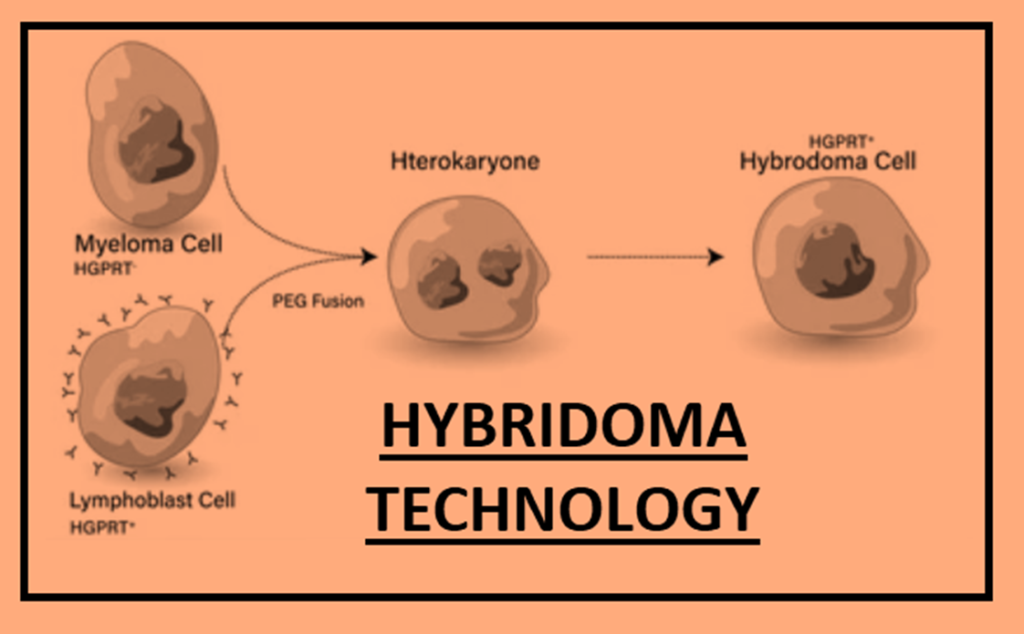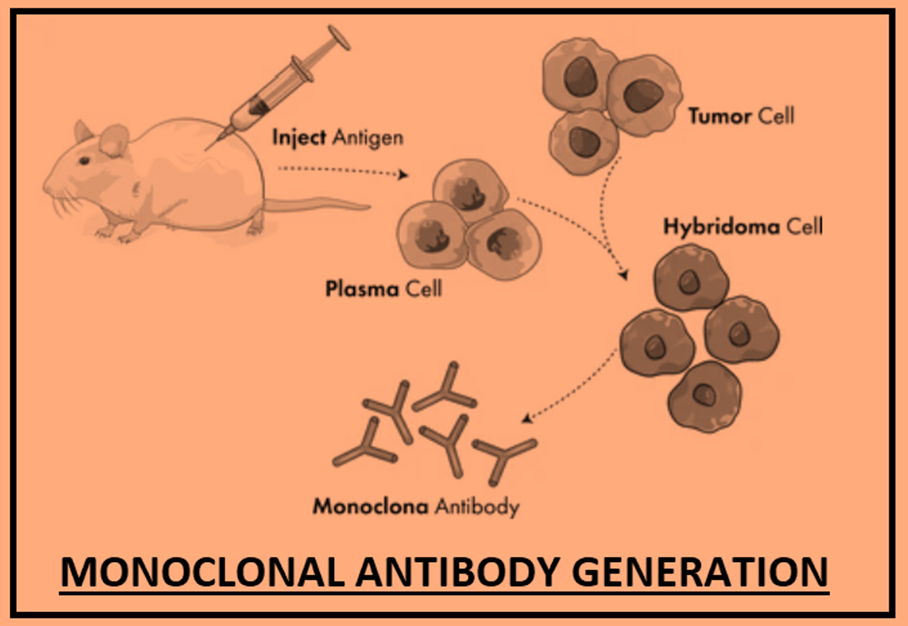INTRODUCTION
Antibody generation by Hybridoma technology is a technique used to produce monoclonal antibodies, which are highly specific and homogeneous antibodies that recognize a single epitope on an antigen. The development of hybridoma technology revolutionized the field of immunology, as it allowed for the large-scale production of highly specific monoclonal antibodies, enabling a wide range of applications in research, diagnostics, and therapeutics.
The process of hybridoma technology involves fusing an antibody-producing B-cell with a cancerous myeloma cell to create a hybridoma cell line that can produce monoclonal antibodies indefinitely. The B-cell provides the specificity and affinity of the antibody, while the myeloma cell provides the immortalization of the cell line. This process was first developed by Georges Köhler and Cesar Milstein in 1975, which led to the Nobel Prize in Physiology or Medicine in 1984.
The first step in hybridoma technology is immunization, which involves injecting an animal with an antigen of interest. The immune response leads to the production of B-cells specific to the antigen, which can be harvested from the spleen. These B-cells are then fused with myeloma cells, which are cancerous cells that can grow indefinitely in vitro. The resulting hybridoma cells are selected for their ability to produce monoclonal antibodies specific to the antigen of interest.

The hybridoma cells are screened to identify clones that produce the desired antibody. Once identified, these clones can be expanded in culture to produce large quantities of the monoclonal antibody. The monoclonal antibodies produced by hybridoma cells have a defined binding affinity and specificity, which makes them ideal for diagnostic and therapeutic applications.
One of the key advantages of hybridoma technology is the ability to produce highly specific and homogeneous monoclonal antibodies, which are uniform in their antigen-binding properties. In contrast, polyclonal antibodies, which are produced by injecting animals with an antigen, are a mixture of different antibodies, each with varying binding affinities and specificities.
HISTORY
Hybridoma technology is a groundbreaking method for generating highly specific monoclonal antibodies that revolutionized the field of immunology. In 1975, Georges Köhler and Cesar Milstein developed this technique, which involves fusing an antibody-producing B-cell with a cancerous myeloma cell to create a hybridoma cell line capable of producing monoclonal antibodies. This process allowed for the large-scale production of highly specific antibodies with a defined binding affinity, making them ideal for diagnostic and therapeutic applications.
Since its inception, hybridoma technology has been widely used in research, diagnostics, and therapeutics. Monoclonal antibodies derived from hybridoma cells have been used to develop new therapies for a wide range of medical conditions, including cancer, autoimmune disorders, and infectious diseases. Additionally, these highly specific monoclonal antibodies have played a critical role in the development of diagnostic assays for a variety of medical conditions.
PROCEDURE OF HYBRIDOMA TECHNOLOGY
The process of hybridoma technology involves several steps, including immunization, cell fusion, and monoclonal antibody production. The following is a brief overview of the procedure:

- Immunization: The first step in hybridoma technology is immunization, which involves injecting an animal, such as a mouse or rabbit, with an antigen of interest. This stimulates the production of B-cells specific to the antigen, which can be harvested from the spleen.
- Cell fusion: The harvested B-cells are then fused with myeloma cells, which are cancerous cells that can grow indefinitely in vitro. This fusion is typically accomplished by treating the cells with a chemical such as polyethylene glycol, which causes them to fuse together.
- Selection: The resulting hybridoma cells are then selected for their ability to produce monoclonal antibodies specific to the antigen of interest. This is typically done by growing the cells in a selective medium that only allows hybridoma cells to survive.
- Screening: The hybridoma cells are screened to identify clones that produce the desired antibody. This is typically done by testing the antibodies for their specificity and affinity to the antigen.
- Expansion: Once identified, the clones can be expanded in culture to produce large quantities of the monoclonal antibody. This can be done using specialized bioreactors or culture flasks.
- Purification: Finally, the monoclonal antibodies produced by the hybridoma cells are purified to remove any impurities or contaminants. This typically involves using techniques such as chromatography or ultracentrifugation.
- The resulting monoclonal antibodies are highly specific and homogeneous, with a defined binding affinity. This makes them ideal for a wide range of applications, including diagnostic assays, therapeutic treatments, and research applications.

APPLICATION
Hybridoma technology is a significant technological advancement in the field of biotechnology and has numerous applications in research, diagnostics, and therapeutics. Its significance can be summarized as follows:
Production of monoclonal antibodies: Hybridoma technology has enabled the production of highly specific and pure monoclonal antibodies that are used in a wide range of research, diagnostic, and therapeutic applications. These monoclonal antibodies can recognize and bind to specific antigens with high affinity and specificity, making them valuable tools in various fields.
Development of new therapies: The production of monoclonal antibodies through hybridoma technology has led to the development of numerous therapeutic drugs. Monoclonal antibodies can target specific molecules in the body, such as cancer cells or inflammatory cytokines, making them effective treatments for a wide range of diseases.
Advancement of immunology research: Hybridoma technology has significantly advanced our understanding of the immune system and its role in disease. It has enabled the development of new techniques for studying the immune system, identifying new targets for drug development, and elucidating the mechanisms of diseases.
Improved diagnostic techniques: Monoclonal antibodies produced through hybridoma technology are used in various diagnostic techniques, such as ELISAs, western blotting, and flow cytometry. These techniques enable the rapid and accurate detection of antigens and biomarkers, which can be used to diagnose diseases, monitor disease progression, and evaluate the efficacy of treatments.
Increased efficiency and reproducibility: Hybridoma technology allows for the large-scale production of monoclonal antibodies, which are highly reproducible and have consistent quality. This has increased the efficiency of research and the production of therapeutic drugs, making them more accessible to patients.
CONCLUSION
In conclusion, hybridoma technology is a powerful tool in the field of biotechnology that has had a significant impact on research, diagnostics, and therapeutics. It has enabled the production of highly specific monoclonal antibodies that have a wide range of applications, from diagnosing diseases to treating them. The technology has advanced our understanding of the immune system and its role in disease and has led to the development of new therapies. Its importance cannot be overstated, as it has improved the efficiency and reproducibility of research and drug production, ultimately benefiting patients by providing them with more effective treatments.
Discover more from ZOOLOGYTALKS
Subscribe to get the latest posts sent to your email.

